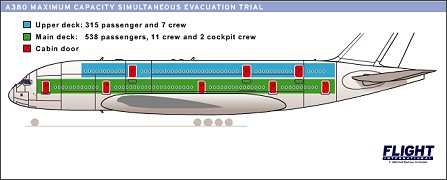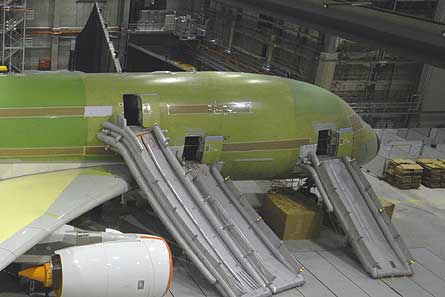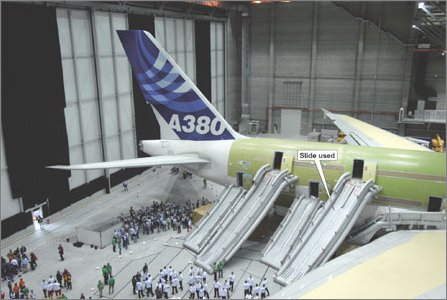Flight's Kieran Daly was the only journalist to take part in the superjumbo’s full-scale evacuation test. Here is his exclusive first-hand account.
For an organisation as obsessed with controlling its processes as a major commercial airframer, a full-scale evacuation test of one of its aircraft is about as horribly uncontrolled as life can be.
Suddenly, years of research and engineering, plus billions of dollars of investment, are at the mercy of any one of hundreds of untrained volunteers.
One human misstep, an unexpected claustrophobic reaction, or one act of baffling stupidity, and the manufacturer could find itself facing implacable regulators who decline to approve the aircraft.
The best scenario then is that it all has to be done again; the worst, that failure strikes once more and a redesign delays the programme by months while millions of dollars bleed away.
Put those risks alongside the proven safety hazard to the participants and never has the dilemma been more acute than for Airbus and the European and US regulators overseeing A380 certification.
|
Consideration was given to modelling the evacuation instead, but the European Aviation Safety Agency (EASA) and the US Federal Aviation Administration decided that the unprecedented size of the aircraft, and its novel twin-deck configuration, made a live evacuation test unavoidable.
The underlying concept of the A380 evacuation is simple: each of the two decks is treated as a separate, conventional aircraft cabin that in theory can be cleared in the requisite 90s – as in any other type. For rule-making purposes, however, the whole aircraft still has to be evacuated in that time.
Apart from the sheer numbers involved, there are at least three significant differences from other evacuations: the physical and psychological effects of the unprecedented height of the upper-deck slides; the existence of a wide staircase permitting movement between the decks with unpredictable consequences; and the increased possibility of interference between the numerous fleeing passengers as they try to run away from the aircraft.
Advantages include: the absence of overwing exits requiring passengers to remove and dispose of a door; the use throughout of Goodrich-supplied, new-generation, twin-lane slides; and the increased space in the aircraft, particularly close to the doors.
I joined more than 1,000 volunteers, drawn 50/50 from Airbus employees and local gymnasium members, who took part in the evacuation test at Airbus’s Finkenwerder plant in Hamburg on 26 March.
Most of what turned into a long day was taken up with lengthy administrative processing, plus a superficial “agility” test and, hours later, some warm-up exercises before going on the aircraft.
There has been much internet speculation about the agility test, but the reality is that it is probably misnamed, and would be unlikely to exclude anyone other than the very elderly or clinically infirm.
EASA and FAA regulations require that 35% of the participants must be aged over 50, a minimum 40% must be female, and 15% female and over 50.
When we entered the half of the hangar containing the aircraft, we could see only the forward section – everything aft of the foremost upper-deck door being screened by a huge black curtain. The view underneath the aircraft was also entirely blocked by a wall of cardboard boxes. Once inside the aircraft we found all the window blinds lowered.
|
| Curtain blocking evacuees' view of the left side is visible |
The primary reason was so that we could not see which of the upper-deck slides had been, for safety reasons, pre-deployed, and which of them had been deliberately blocked to simulate real-life door unavailability.
Airbus says EASA had determined that pre-deploying the slides conferred no advantage as the doors take about the same time to open as the slides do to deploy.
The group I was in entered the upper deck to be greeted by members of a Lufthansa line crew as if for a normal flight. Boarding was lengthy as we had no idea where we would be sitting and our seat numbers, matching our numbered white bibs, gave no indication of row or seat position.
I eventually discovered mine was an aisle seat, just aft of the wing in a left-hand block of just two, with our backs to what would be the lavatories in a properly configured aircraft. This A380, MSN007 (F-WWSD), had test equipment and observers housed in crude wooden cabins where the lavatories and galleys would normally be.
The rest of the cabin that I could see was configured in a classic, all-economy layout with 30in (750mm) seat pitch. In all configurations envisaged by the current customer list, there would be at least 300 fewer passengers on board.
It was obvious from the conventional safety card in the seatback that my closest door was immediately behind the lavatories – one of a pair opposite each other. The next closest pairs were 14 rows ahead of me, or about a dozen rows aft at the back of the cabin.
The Lufthansa flight attendants gave the usual pre-flight safety briefing, and the safety card reminded me that there is only one type of door on the aircraft, allowing easier memorising of the opening sequence.
"The cabin suddenly went dark, there was a moment's silence and then I heard the attendants shouting" |
Without warning the cabin went suddenly dark, there was a moment’s silence, and then I heard the flight attendants shouting. I was surprised to find the voices sounded a long way off and not very loud. Furthermore, they were in German, which I don’t understand.
In retrospect, this was the least realistic aspect of the whole exercise, with nothing other than the sudden darkness indicating an emergency, and I strongly recall thinking “this must be it then” before moving. With the sensory cues of a real emergency, and also with an English language command, I believe I would have reacted a second or two faster.
I left my seat and collided with the woman in the aisle seat opposite, but led the way to the door behind me I had previously chosen, now on my right side as I faced aft. By the time I reached it, however – perhaps in a couple of seconds – a male flight attendant was already shouting that it did not work and directing us to other doors.
By the pale emergency lighting I recall looking aft and seeing the aisle full of people leaving for the rear door, which looked far away. I was paid no attention to the flight attendant and decided immediately to head for the opposite door. Seeing the area between the two doors, in front of the first seat row, full of people, I clambered along the empty row of seats behind and was quickly at the door.
I remember being conscious that, in my area, people were moving in a controlled fashion, fairly quietly, and what I thought was surprisingly slowly.
There was some jostling for space in the congested door area as people manoeuvred on to the slide and I recall jumping on to the right-hand lane of the slide ahead of a slower-moving person.
The sudden transition to the outside of the aircraft is particularly vivid in my memory, and I have little doubt must be extremely disorienting in a genuine emergency when environmental factors might also play a key role.
The huge hangar was pitch black apart from the dim yellow glow from the LED lighting in the walls of the slide and, compared with the aircraft interior, it was suddenly very noisy, with dozens of simulated rescue workers screaming from the darkness for us to jump and run away.
There has been much discussion of the risk of passengers hesitating at the top of the upper-deck slides, but from my own experience I think the likelihood is overstated.
That is because my overwhelming recollection of the whole experience is the way in which a kind of tunnel vision set in throughout, so that my universe “shrank” and I was primarily conscious only of what was happening within a couple of metres of me. I suspect that with the added adrenaline of a real emergency that phenomenon could only be intensified.
My final memory is of standing on the ground and watching the extraordinary sight of the huge A380, bathed in dim yellow light, with all the right-hand side slides deployed and hundreds of shadowy figures sliding down them before the appearance of the flight attendants indicated everyone was out.
|
| Evacuees in white bibs, and Airbus staff in green and orange shirts, surround the A380 moments after the test |
Airbus subsequently confirmed that EASA had chosen to disable all the slides on the left-hand side.
Our watches having been removed before the test, we had no way of timing the operation even if we had wished, but within minutes, while still in near-darkness, Airbus programme officials could be seen cheering and pumping their fists in the air. Two days later EASA confirmed that the 853 passengers, 18 cabin crew, and two pilots had indeed evacuated in 78s.
Neither EASA nor Airbus has commented on whether passengers used the A380’s uniquely wide staircase during the exercise, or on any issues of interference between the streams of evacuees on the ground.
The agencies warned before the test that merely clearing the aircraft in the targeted 90s would not guarantee approval. They reserved the right to withhold approval if they saw anything about the process with which they were unhappy. One possibility was that a flight attendant might successfully clear an area of congestion, raising questions over whether the evacuation would have been accomplished with, for example, a different flight attendant. Although the agencies intended to study all the extensive internal and external infrared video of the exercise, there was no immediate suggestion that any serious difficulty had been encountered.
KIERAN DALY / HAMBURG
Blog:
Read more of Kieran Daly’s immediate thoughts of the experience in his blog, filed from the hangar
Source: Flight International



















